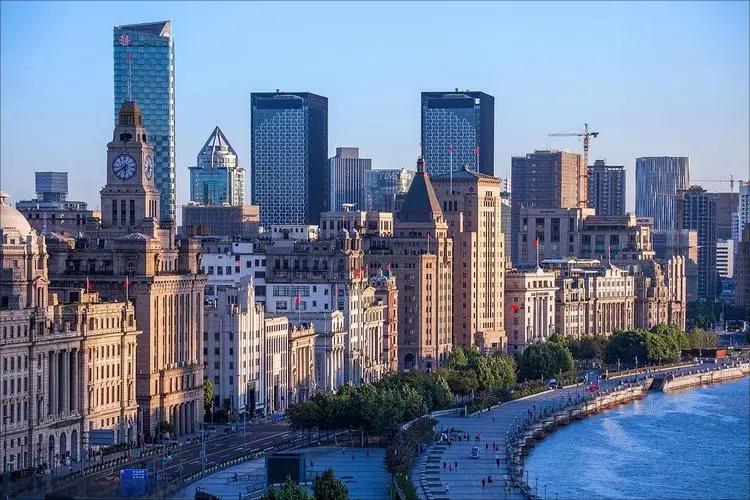Shanghai Centennial Universal Architecture Complex
Shanghai's Hundred Years of Universal Architecture Complex, mainly located on the Bund, is composed of a series of Western-style buildings built in the late 19th century to the early 20th century. These buildings bring together a variety of architectural styles and are witnesses to Shanghai's modern history and the history of the Concession, reflecting the exchange of Chinese and Western cultures during that period. The following are some of the typical buildings in the Shanghai Centennial Universal Building Complex:

- HSBC Building (now Pudong Development Bank Building)
Built: 1923
Architectural Style: Neoclassical
Features: This building was once the most luxurious bank building in the Far East at that time, with a grand exterior and ornate interior decorations with large domes and stone carvings. It has now been converted into the headquarters of Shanghai Pudong Development Bank. - Bank of China Building
Built: 1937
Architectural style: a fusion of traditional Chinese elements and modern architectural style
Features: This building was designed and built by the Bank of China itself. The façade of the building presents a combination of Chinese and Western styles, symbolizing the rise of China's national financial industry in that era. - Peace Hotel (formerly Chinachem Hotel)
Built: 1929
Architectural style: Art Deco
Features: Built by Victor Sassoon, a wealthy Shanghai businessman, the Peace Hotel is known for its Art Deco style, with its copper roofs and spires. The Peace Hotel was once a gathering place for high society celebrities and foreign tourists. - Shanghai Customs Building
Built: 1927
Architectural Style: Neoclassical
Features: The most notable feature of the building is the clock tower on top, which used to be one of the landmarks of Shanghai. The clock tower is equipped with a large clock, which still keeps time and has become one of the symbols of the Bund. - Jardine Matheson Building
Built: 1920
Architectural Style: English Classical Revival
Features: The façade of this building adopts Roman columns and classical decorations, and the design is simple but noble. The exterior materials and interior decoration of the building show the tradition of British architecture at that time. - Dongfeng Hotel (former Licha Hotel)
Built: 1907
Architectural style: Renaissance style
Features: It was once one of the tallest buildings on the Bund and one of the most luxurious hotels in the Far East at that time. The facade of the building is richly decorated with windows, columns and other decorative elements characteristic of Renaissance architecture. - Sassoon Building (South Building of Peace Hotel)
Built in 1929
Architectural Style: Gothic and Renaissance
Features: Built by the Sassoon family, the golden spire at the top of the building is the symbol of the building, which is full of European flavor and was once called the first building in the Far East. - China Merchants Building
Built: 1901
Architectural style: English Classical Revival style
Features: This building was originally the seat of China Merchants, a famous Chinese shipping company. With its solemn and elegant appearance, and a blend of Western architectural style elements, it is one of the representative buildings designed and constructed by the Chinese themselves. - Chinese-Russian Daosheng Bank Building (now Shanghai Bund Art Museum)
Built: 1902
Architectural Style: Eclecticism
Features: The building incorporates the beautifully carved style of French architecture, with Roman columns and sculptures. This building witnessed the early economic exchanges between China and Russia. - Far Eastern Bank Building
Built: 1921
Architectural Style: Neoclassical
Features: The design of the front façade of the building is dominated by tall columns, and the building structure is imposing, and it is the home of one of the important financial institutions in Shanghai at the beginning of the 20th century.
Since its completion, the Universal Building Complex on the Bund in Shanghai has attracted the attention of countless literary figures with its unique architectural aesthetics and historical value. Through novels, essays and poems, they have depicted the magnificence of these complexes, their unique historical significance, and the spirit of the times they carry. The following are the descriptions of the Bund and its features by some famous literary figures:
Mao Dun depicted the bustling and magnificent scene of the Bund in his prose The Bund. He wrote:
“By the Huangpu River, a building rises up to the sky, the Bund is like a magnificent stage, performing a feast of modern civilization. Western-style buildings are lined up in a solemn manner, as if condensing the glorious memories of the entire Shanghai Bund.”
In her novel Love in a Fallen City, Eileen Chang mentions the prosperity of Shanghai several times, and she depicts the night scene of the Bund through the perspective of her heroine, Bai Liusu:
“The two banks of the Pu River were lit up like a dream, the water sparkled, reflecting the luxurious buildings, and the buildings on the Bund were like a row of silent giants guarding the bustling city.”
Yu Dafu mentioned in his essay “Winter Scene in Jiangnan”:
“Looking from the Bund, the complex of buildings looks like a palace, Western in style, Eastern in heart. The winter sunlight sprinkled on the stone walls of the buildings, the classical flavor and the warmth of Jiangnan blended together, and actually gave birth to a touch of poetic beauty.”
Xu Zhimo's reference to the Bund in “The Kangqiao I Know” is full of romanticism:
“The buildings on the Bund are a piece of frozen music. They sing the notes of history in stone, and with the waves of the Huangpu River as a backdrop, they compose a melody of East-West symphony."
